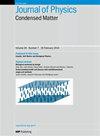Large scale Raman spectrum calculations in defective 2D materials using deep learning.
IF 2.3
4区 物理与天体物理
Q3 PHYSICS, CONDENSED MATTER
引用次数: 0
Abstract
We introduce a machine learning prediction workflow to study the impact of defects on the Raman response of 2D materials. By combining the use of machine-learned interatomic potentials, the Raman-active Γ-weighted density of states method and splitting configurations in independant patches, we are able to reach simulation sizes in the tens of thousands of atoms, with diagonalization now being the main bottleneck of the simulation. We apply the method to two systems, isotopic graphene and defective hexagonal boron nitride, and compare our predicted Raman response to experimental results, with good agreement. Our method opens up many possibilities for future studies of Raman response in solid-state physics.
基于深度学习的缺陷二维材料大规模拉曼光谱计算。
我们引入了一个机器学习预测工作流来研究缺陷对二维材料拉曼响应的影响。通过结合使用机器学习的原子间势、拉曼主动γ加权态密度方法和独立斑块中的分裂构型,我们能够达到数万个原子的模拟尺寸,而对角化现在是模拟的主要瓶颈。我们将该方法应用于同位素石墨烯和缺陷六方氮化硼两种体系,并将预测的拉曼响应与实验结果进行了比较,结果吻合良好。我们的方法为固体物理中拉曼响应的未来研究开辟了许多可能性。
本文章由计算机程序翻译,如有差异,请以英文原文为准。
求助全文
约1分钟内获得全文
求助全文
来源期刊

Journal of Physics: Condensed Matter
物理-物理:凝聚态物理
CiteScore
5.30
自引率
7.40%
发文量
1288
审稿时长
2.1 months
期刊介绍:
Journal of Physics: Condensed Matter covers the whole of condensed matter physics including soft condensed matter and nanostructures. Papers may report experimental, theoretical and simulation studies. Note that papers must contain fundamental condensed matter science: papers reporting methods of materials preparation or properties of materials without novel condensed matter content will not be accepted.
 求助内容:
求助内容: 应助结果提醒方式:
应助结果提醒方式:


